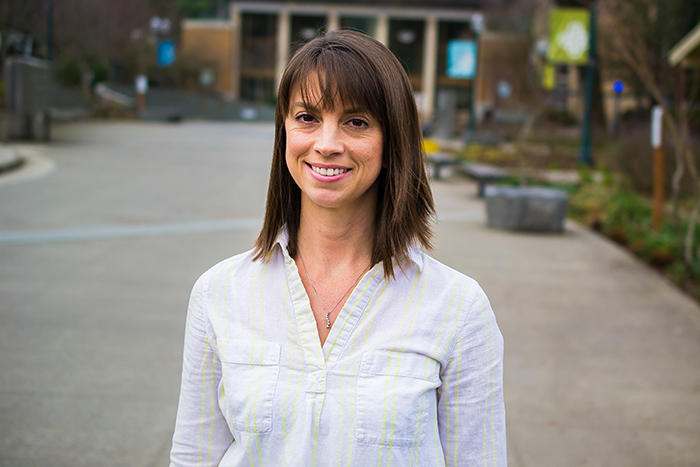We’re taking time over the following weeks to get to know the members of the GSA’s Early Career Scientist Committees. Join us every week to learn more about our early career scientist advocates.

Lindsay Holden
Steering Committee
Portland State University
SMART Scholar, US Army Public Health Center
Research Interest
Differences between individuals at the DNA level fascinate me. Small changes like single nucleotide polymorphisms (SNPs) and small insertions or deletions (indels) can have huge impacts on the development or progression of genetic diseases. I’m really amazed by copy number variants (CNVs), where more or less than diploid, two-copy DNA exists across a region; up to 15% of the human genome is covered in CNVs. Not all of these regions fall across genes, but many do.
From the 1000 Genomes Project, we know that human populations segregate across historical geographic divisions, such as those from Asia, Europe, the Americas, and Africa. We also know that the genetic differences between these populations result in phenotypic changes such as differential sensitivity to chemicals, where some populations are more sensitive to environmental exposures than others. Most research focuses on SNPs as markers associated with these different phenotypes, but less attention has been paid to the role of genomic CNVs. I’m interested in identifying genomic CNV regions that contribute to the variable chemical susceptibility that exists across populations. My long-term goal is to use this natural genetic variability to predict population-based susceptibility to chemicals and use that knowledge towards better public health.
I use zebrafish as a model to explore the genomic drivers of chemical susceptibility. Zebrafish are a great model because each laboratory strain has well-described differences in CNV. Moreover, strains differ in their susceptibility to polychlorinated biphenyls (PCBs), a well-studied chemical that is ubiquitous in our environment. Exposure to PCBs can cause negative health effects such as skin irritation in adults, neurobehavioral and immunologic changes in children, and cancer in animals. I am using the PCB-susceptibility phenotype to assess whether CNVs are driving differences in susceptibility across strains. Once we have a clear understanding of the mechanism in zebrafish, we can translate that information to humans with public health goals like predicting chemical sensitivity, prioritizing remediation of contaminated sites, and informing healthcare choices for those who have been exposed to environmental contaminants.
As a PhD-trained scientist, you have many career options. What career paths interest you the most?
I’m supported by the Science, Mathematics And Research for Transformation (SMART) Scholarship for Service Program. The SMART scholarship is a Department of Defense (DoD)-funded program that supports students through graduate school, matches them with DoD labs for summer internships, and then employs them after degree completion. I have been matched with the Toxicology Directorate within the US Army Public Health Center, and I will be working with the Health Effects Division as a civilian scientist to perform toxicological research around environmental exposures. My graduate research in genomics and toxicology has been great preparation for this next career step because it exposed me to the complex crosstalk between molecular biology and chemical exposure. The field of toxicology is constantly changing due to regulatory decisions and the introduction of new chemicals, and I look forward to building my scientific expertise, working in a dynamic field, and applying new, exciting genomic tools to the classic toxicology framework.
In addition to your research, how else do you want to advance the scientific enterprise?
As a scientist, I view myself as an interpreter. I translate data into meaningful results, protocols into working assays, and information from one field into another. This requires thoughtful communication, clarification, and interpretation. I hope to advance the scientific enterprise by encouraging more scientists to view themselves as interpreters. Miscommunication between scientists, especially across disciplines, is very common, but it can be remedied with better communication skills. Not only are we communicating between labs and institutions, we are also communicating with the public and with officials who govern our budgets. I envision providing training in communication with the scientific and non-scientific communities to achieve this goal. By fostering collaborations across disciplines and by clearly communicating the intent and implications of our research, I hope to make science more accessible.
As a leader within the Genetics Society of America, what do you hope to accomplish?
My goal is to provide resources and tools that graduate students, postdocs, and early career professionals need to support themselves at the start of their careers. As a junior scientist at the beginning of my career, I find myself comparing my accomplishments with the senior scientists around me, which can be quite humbling. Having support for the graduate student-to-career-scientist transition is helping me discover and refine my own personal professional identity. I have found that professional networking, training and funding opportunities, and networking with peers have been the most helpful in my own professional development. Junior and senior colleagues are great resources for overcoming early career challenges, training opportunities help fill existing gaps that I have identified in my professional portfolio, and early funding is a huge validation that I am succeeding as a scientist. In my new role on the steering committee for the ECS Leadership program, I hope to support the continuation of the ECS Weekly Newsletter, increase graduate student and postdoc participation and collaboration at GSA meetings, foster our scientific voices in the public sphere, and support diverse membership and leadership at GSA.
Previous leadership experience
- Event Coordinator and President, Biology Investigation & Outreach—Portland State University
- Leadership Fellow, Community Engagement and Social Justice cohorts, Student Activities and Leadership Program—Portland State University
- Lead TA, Certificate for Innovation in College Teaching, College of Liberal Arts & Sciences—Portland State University
- Mentor, Louis Stokes Alliance for Minority Participation (LSAMP)—Portland State University
- Science Expo Judge—Portland Public Schools
Social media































